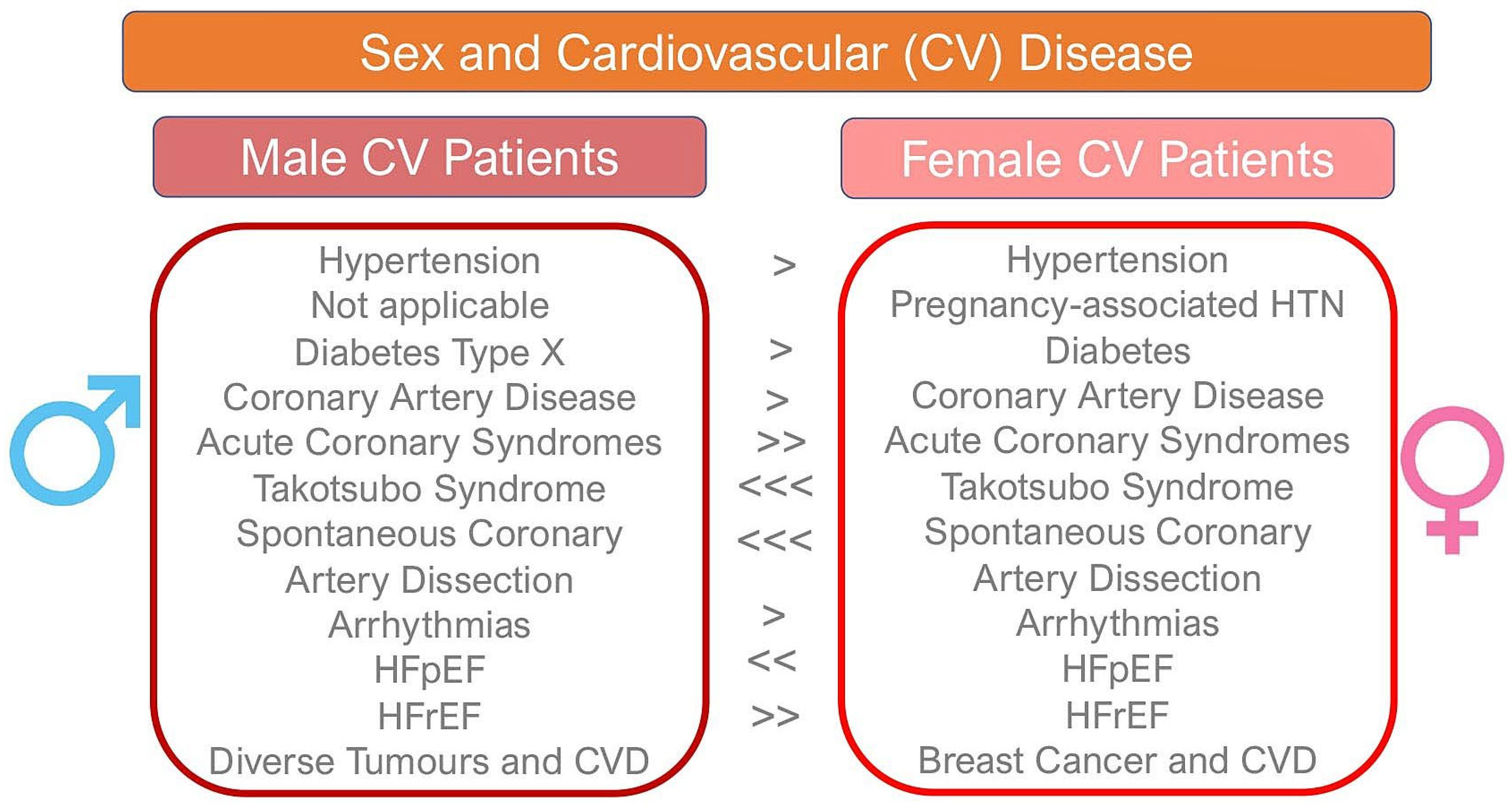Sex and Cardiovascular Disease
References
- Vinereanu, D.; Stevens, S.R.; Alexander, J.H.; Al-Khatib, S.M.; Avezum, A.; Bahit, M.C.; et al. Clinical outcomes in patients with atrial fibrillation according to sex during anticoagulation with apixaban or warfarin: A secondary analysis of a randomized controlled trial. Eur. Heart J. 2015, 36, 32683275. [Google Scholar] [CrossRef] [PubMed]
- Timmis, A.; Vardas, P.; Townsend, N.; Torbica, A.; Katus, H.; De Smedt, D.; et al. Atlas Writing Group, European Society of Cardiology. European Society of Cardiology: Cardiovascular disease statistics 2021. Eur. Heart J. 2022, 43, 716–799. [Google Scholar] [CrossRef] [PubMed]
- Alotaibi, G.S.; Almodaimegh, H.; McMurtry, M.S.; Wu, C. Do women bleed more than men when prescribed novel oral anticoagulants for venous thromboembolism? A sex-based meta-analysis. Thromb. Res. 2013, 132, 185–189. [Google Scholar] [CrossRef] [PubMed]
- Haider, A.; Bengs, S.; Luu, J.; Osto, E.; Siller-Matula, J.M.; Muka, T.; et al. Sex and gender in cardiovascular medicine: Presentation and outcomes of acute coronary syndrome. Eur. Heart J. 2020, 41, 1328–1336. [Google Scholar] [CrossRef] [PubMed]
- Moran, C.A.; Collins, L.F.; Beydoun, N.; Mehta, P.K.; Fatade, Y.; Isiadinso, I.; et al. Cardiovascular Implications of Immune Disorders in Woman. Circ. Res. 2022, 130, 593–610. [Google Scholar] [CrossRef] [PubMed]
- Lam, C.S.; Gamble, G.D.; Ling, L.H.; Sim, D.; Leong, K.T.; Yeo, P.S.; et al. Mortality associated with heart failure with preserved vs. reduced ejection fraction in a prospective international multi-ethnic cohort study. Eur. Heart J. 2018, 39, 1770–1780. [Google Scholar] [CrossRef] [PubMed]
- Lam, C.S.; Arnott, C.; Beale, A.L.; Chandramouli, C.; Hilfiker-Kleiner, D.; Kaye, D.M.; et al. Sex differences in heart failure. Eur. Heart J. 2019, 40, 3859–3868c. [Google Scholar] [CrossRef] [PubMed]
- Sotomi, Y.; Hikoso, S.; Nakatani, D.; Mizuno, H.; Okada, K.; Dohi, T.; et al. PURSUIT-HFpEF Investigators. Sex Differences in Heart Failure With Preserved Ejection Fraction. J. Am. Heart Assoc. 2021, 10, e018574. [Google Scholar] [CrossRef] [PubMed]
- Wenzl, F.A.; Kraler, S.; Ambler, G.; Weston, C.; Herzog, S.A.; Räber, L.; et al. Sex-specific evaluation and redevelopment of the GRACE score in non-ST-segment elevation acute coronary syndromes in populations from the UK and Switzerland: A multinational analysis with external cohort validation. Lancet 2022, 400, 744–756. [Google Scholar] [CrossRef] [PubMed]
- Templin, C.; Ghadri, J.R.; Diekmann, J.; Napp, L.C.; Bataiosu, D.R.; Jaguszewski, M.; et al. Clinical Features and Outcomes of Takotsubo (Stress) Cardiomyopathy. N. Engl. J. Med. 2015, 373, 929–938. [Google Scholar] [CrossRef] [PubMed]
- Adlam, D.; Alfonso, F.; Maas, A.; Vrints, C.; al-Hussaini, A.; Bueno, H.; Writing Committee; et al. European Society of Cardiology, acute cardiovascular care association, SCAD study group: A position paper on spontaneous coronary artery dissection. Eur. Heart J. 2018, 39, 3353–3368. [Google Scholar] [CrossRef] [PubMed]
- Staerk, L.; Sherer, J.A.; Ko, D.; Benjamin, E.J.; Helm, R.H. Atrial Fibrillation: Epidemiology, Pathophysiology, and Clinical Outcomes. Circ. Res. 2017, 120, 1501–1517. [Google Scholar] [CrossRef] [PubMed]
- Westerman, S.; Wenger, N. Gender Differences in Atrial Fibrillation: A Review of Epidemiology, Management, and Outcomes. Curr. Cardiol. Rev. 2019, 15, 136–144. [Google Scholar] [CrossRef] [PubMed]
- Ko, D.; Rahman, F.; Schnabel, R.B.; Yin, X.; Benjamin, E.J.; Christophersen, I.E. Atrial fibrillation in women: Epidemiology, pathophysiology, presentation, and prognosis. Nat. Rev. Cardiol. 2016, 13, 321–332. [Google Scholar] [CrossRef] [PubMed]
- Noseworthy, P.A.; Gersh, B.J.; Kent, D.M.; Piccini, J.P.; Packer, D.L.; Shah, N.D.; et al. Atrial fibrillation ablation in practice: Assessing CABANA generalizability. Eur. Heart J. 2019, 40, 1257–1264. [Google Scholar] [CrossRef] [PubMed]
- Cheung, J.W.; Cheng, E.P.; Wu, X.; Yeo, I.; Christos, P.J.; Kamel, H.; et al. Sex-based differences in outcomes, 30-day readmissions, and costs following catheter ablation of atrial fibrillation: The United States Nationwide Readmissions Database 2010-14. Eur Heart J 2019, 40, 3035–3043. [Google Scholar] [CrossRef] [PubMed]
- Lüscher, T.F.; Miller, V.M.; Bairey Merz, C.N.; Crea, F. Diversity is richness: Why data reporting according to sex, age, and ethnicity matters. Eur. Heart J. 2020, 41, 3117–3121. [Google Scholar] [CrossRef] [PubMed]
- Institute of Medicine (US) Committee on Understanding the Biology of Sex and Gender Differences. Exploring the Biological Contributions to Human Health: Does Sex Matter? Wizemann, T.M., Pardue, M.L., Eds.; National Academies Press: Washington, DC, USA, 2001. [Google Scholar]

© 2023 by the authors. Licensee MDPI, Basel, Switzerland. This article is an open access article distributed under the terms and conditions of the Creative Commons Attribution (CC BY) license (https://creativecommons.org/licenses/by/4.0/).
Share and Cite
Lüscher, T.; Flammer, A.; Kuster, G. Sex and Cardiovascular Disease. Cardiovasc. Med. 2023, 26, 67. https://doi.org/10.4414/cvm.2023.02284
Lüscher T, Flammer A, Kuster G. Sex and Cardiovascular Disease. Cardiovascular Medicine. 2023; 26(3):67. https://doi.org/10.4414/cvm.2023.02284
Chicago/Turabian StyleLüscher, Thomas, Andreas Flammer, and Gabriela Kuster. 2023. "Sex and Cardiovascular Disease" Cardiovascular Medicine 26, no. 3: 67. https://doi.org/10.4414/cvm.2023.02284
APA StyleLüscher, T., Flammer, A., & Kuster, G. (2023). Sex and Cardiovascular Disease. Cardiovascular Medicine, 26(3), 67. https://doi.org/10.4414/cvm.2023.02284


